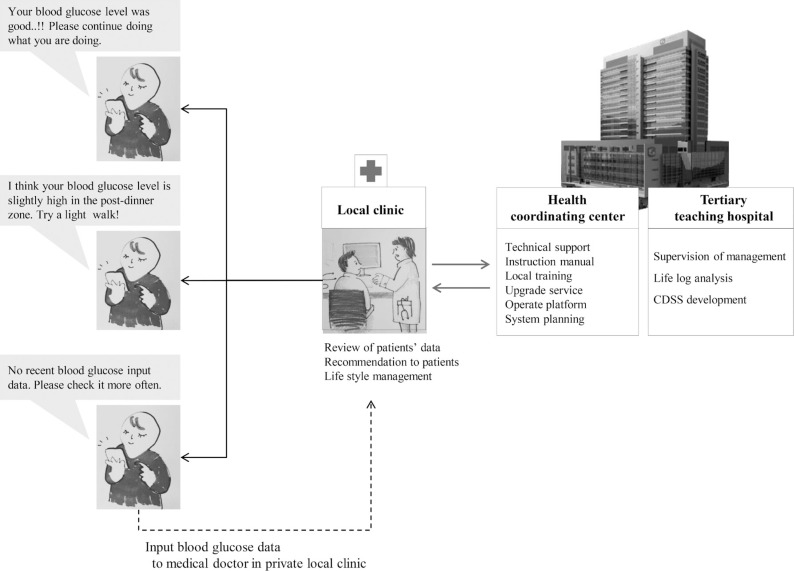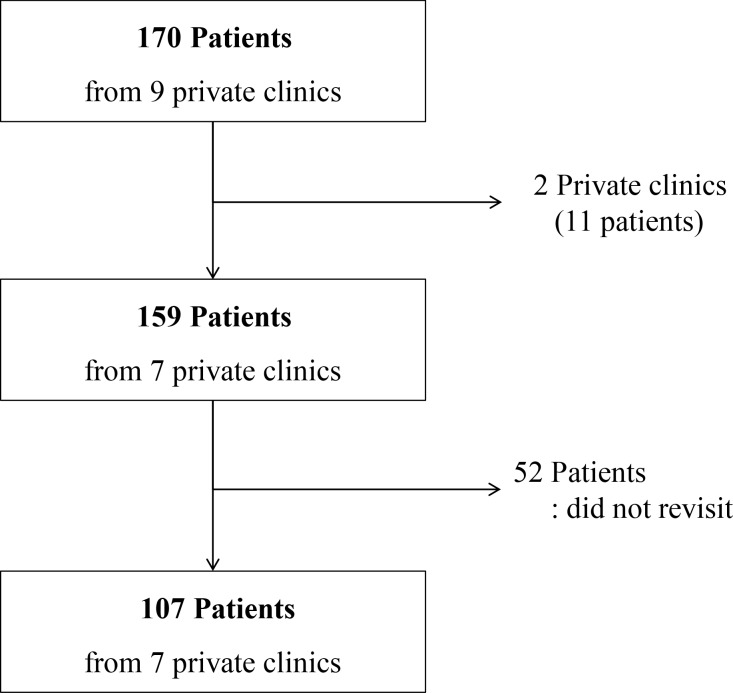Diabetes Metab J.
2017 Jun;41(3):213-222. 10.4093/dmj.2017.41.3.213.
Satisfaction Survey on Information Technology-Based Glucose Monitoring System Targeting Diabetes Mellitus in Private Local Clinics in Korea
- Affiliations
-
- 1Department of Medical Informatics, College of Medicine, The Catholic University of Korea, Seoul, Korea.
- 2Department of Endocrinology and Metabolism, College of Medicine, The Catholic University of Korea, Seoul, Korea. drhopper@catholic.ac.kr
- 3National Evidence-based healthcare Collaborating Agency (NECA), Seoul, Korea.
- 4Department of Preventive Medicine, Korea University College of Medicine, Seoul, Korea.
- KMID: 2392496
- DOI: http://doi.org/10.4093/dmj.2017.41.3.213
Abstract
- BACKGROUND
Private local clinics in Korea have little experience with information technology (IT)-based glucose monitoring (ITGM). Our aim is to examine user satisfaction and the possibility of using ITGM service practically.
METHODS
Patients sent their blood glucose levels to physicians in local clinics. The physicians reviewed the blood glucose values online and provided personal consultations through text messaging or phone calls. Thereafter, a satisfaction survey on the ITGM service, the modified Morisky scale, and patient assessment of chronic illness care were administered.
RESULTS
One hundred and seventy patients from seven private local clinics used the ITGM. Overall satisfaction, including that about the ITGM service, the device, and its usefulness, was rated higher than "mostly satisfied" (score 4.2±0.8 out of 5.0) and even higher among the elderly. Satisfaction was positively associated with age, especially in those older than 60 years. The main reason for intent for future use of the service was the time/place flexibility. Highly motivated patients tended to answer positively regarding information satisfaction (P=0.0377).
CONCLUSION
Our study is the first to investigate ITGM satisfaction in private local clinics. The feasibility of users utilizing ITGM should be clarified, and future clinical research on the service's clinical effects and cost-benefit analysis is needed.
MeSH Terms
Figure
Cited by 2 articles
-
Apprehensions about Excessive Belief in Digital Therapeutics: Points of Concern Excluding Merits
Hun-Sung Kim
J Korean Med Sci. 2020;35(45):e373. doi: 10.3346/jkms.2020.35.e373.Lessons from Use of Continuous Glucose Monitoring Systems in Digital Healthcare
Hun-Sung Kim, Kun-Ho Yoon
Endocrinol Metab. 2020;35(3):541-548. doi: 10.3803/EnM.2020.675.
Reference
-
1. Yoon KH, Lee JH, Kim JW, Cho JH, Choi YH, Ko SH, Zimmet P, Son HY. Epidemic obesity and type 2 diabetes in Asia. Lancet. 2006; 368:1681–1688. PMID: 17098087.
Article2. Chan JC, Malik V, Jia W, Kadowaki T, Yajnik CS, Yoon KH, Hu FB. Diabetes in Asia: epidemiology, risk factors, and pathophysiology. JAMA. 2009; 301:2129–2140. PMID: 19470990.3. Resnick HE, Foster GL, Bardsley J, Ratner RE. Achievement of American Diabetes Association clinical practice recommendations among U.S. adults with diabetes, 1999-2002: the National Health and Nutrition Examination Survey. Diabetes Care. 2006; 29:531–537. PMID: 16505501.4. Kim HS, Hwang Y, Lee JH, Oh HY, Kim YJ, Kwon HY, Kang H, Kim H, Park RW, Kim JH. Future prospects of health management systems using cellular phones. Telemed J E Health. 2014; 20:544–551. PMID: 24693986.
Article5. Kim HS, Choi W, Baek EK, Kim YA, Yang SJ, Choi IY, Yoon KH, Cho JH. Efficacy of the smartphone-based glucose management application stratified by user satisfaction. Diabetes Metab J. 2014; 38:204–210. PMID: 25003074.
Article6. Carroll AE, DiMeglio LA, Stein S, Marrero DG. Contracting and monitoring relationships for adolescents with type 1 diabetes: a pilot study. Diabetes Technol Ther. 2011; 13:543–549. PMID: 21406011.
Article7. Zolfaghari M, Mousavifar SA, Pedram S, Haghani H. The impact of nurse short message services and telephone follow-ups on diabetic adherence: which one is more effective? J Clin Nurs. 2012; 21:1922–1931. PMID: 22239205.8. Shetty AS, Chamukuttan S, Nanditha A, Raj RK, Ramachandran A. Reinforcement of adherence to prescription recommendations in Asian Indian diabetes patients using short message service (SMS): a pilot study. J Assoc Physicians India. 2011; 59:711–714. PMID: 22616337.9. Schiel R, Thomas A, Kaps A, Bieber G. An innovative telemedical support system to measure physical activity in children and adolescents with type 1 diabetes mellitus. Exp Clin Endocrinol Diabetes. 2011; 119:565–568. PMID: 21472657.
Article10. Kim HS, Kim H, Lee S, Lee KH, Kim JH. Current clinical status of telehealth in Korea: categories, scientific basis, and obstacles. Healthc Inform Res. 2015; 21:244–250. PMID: 26618030.
Article11. Kim SI, Kim HS. Effectiveness of mobile and internet intervention in patients with obese type 2 diabetes. Int J Med Inform. 2008; 77:399–404. PMID: 17881285.
Article12. Kim HS, Sun C, Yang SJ, Sun L, Li F, Choi IY, Cho JH, Wang G, Yoon KH. Randomized, open-label, parallel group study to evaluate the effect of internet-based glucose management system on subjects with diabetes in China. Telemed J E Health. 2016; 22:666–674. PMID: 26938489.
Article13. Cho JH, Choi YH, Kim HS, Lee JH, Yoon KH. Effectiveness and safety of a glucose data-filtering system with automatic response software to reduce the physician workload in managing type 2 diabetes. J Telemed Telecare. 2011; 17:257–262. PMID: 21628421.
Article14. Case Management Society of America: Case Management Adherence Guidelines version 1.0. updated 2004 Jun 1. Available from: http://www.cmsa.org/portals/0/pdf/CMAG.pdf.15. Kim SO. Medication adherence of elderly with hypertension and/or diabetes-mellitus and its' influencing factors. Korean J Clin Pharm. 2011; 21:81–89.16. Bonomi AE, Wagner EH, Glasgow RE, VonKorff M. Assessment of chronic illness care (ACIC): a practical tool to measure quality improvement. Health Serv Res. 2002; 37:791–820. PMID: 12132606.
Article17. Istepanian RS, Zitouni K, Harry D, Moutosammy N, Sungoor A, Tang B, Earle KA. Evaluation of a mobile phone telemonitoring system for glycaemic control in patients with diabetes. J Telemed Telecare. 2009; 15:125–128. PMID: 19364893.18. Cho JH, Chang SA, Kwon HS, Choi YH, Ko SH, Moon SD, Yoo SJ, Song KH, Son HS, Kim HS, Lee WC, Cha BY, Son HY, Yoon KH. Long-term effect of the Internet-based glucose monitoring system on HbA1c reduction and glucose stability: a 30-month follow-up study for diabetes management with a ubiquitous medical care system. Diabetes Care. 2006; 29:2625–2631. PMID: 17130195.19. Lim S, Kim SY, Kim JI, Kwon MK, Min SJ, Yoo SY, Kang SM, Kim HI, Jung HS, Park KS, Ryu JO, Shin H, Jang HC. A survey on ubiquitous healthcare service demand among diabetic patients. Diabetes Metab J. 2011; 35:50–57. PMID: 21537413.
Article20. Cho JH, Lee HC, Lim DJ, Kwon HS, Yoon KH. Mobile communication using a mobile phone with a glucometer for glucose control in type 2 patients with diabetes: as effective as an Internet-based glucose monitoring system. J Telemed Telecare. 2009; 15:77–82. PMID: 19246607.
Article21. Kwon HS, Cho JH, Kim HS, Lee JH, Song BR, Oh JA, Han JH, Kim HS, Cha BY, Lee KW, Son HY, Kang SK, Lee WC, Yoon KH. Development of web-based diabetic patient management system using short message service (SMS). Diabetes Res Clin Pract. 2004; 66(Suppl 1):S133–S137. PMID: 15563964.
Article22. Salthouse TA. The aging of working memory. Neuropsychology. 1994; 8:535–543.
Article23. Dal Bello-Haas VP, O'Connell ME, Morgan DG, Crossley M. Lessons learned: feasibility and acceptability of a telehealth-delivered exercise intervention for rural-dwelling individuals with dementia and their caregivers. Rural Remote Health. 2014; 14:2715. PMID: 25081991.
Article24. Docampo Rama M, de Ridder H, Bouma H. Technology generation and age in using layered user interfaces. Gerontechnology. 2001; 1:25–40.
Article25. Kim HS, Lee KH, Kim H, Kim JH. Using mobile phones in healthcare management for the elderly. Maturitas. 2014; 79:381–388. PMID: 25270725.
Article26. Kim KS, Kim SK, Sung KM, Cho YW, Park SW. Management of type 2 diabetes mellitus in older adults. Diabetes Metab J. 2012; 36:336–344. PMID: 23130317.
Article27. Park G, Lee JH, Kim KS. Study on effective improvement of mobile phone sound quality in a noise environment for the hearing-impaired. Korean J Audiol. 2013; 17:78–82. PMID: 24653911.
Article28. Czaja SJ, Charness N, Fisk AD, Hertzog C, Nair SN, Rogers WA, Sharit J. Factors predicting the use of technology: findings from the Center for Research and Education on Aging and Technology Enhancement (CREATE). Psychol Aging. 2006; 21:333–352. PMID: 16768579.
Article29. Pattison M, Stedmon A. Inclusive design and human factors: designing mobile phones for older users. Psychnol J. 2006; 4:267–284.
- Full Text Links
- Actions
-
Cited
- CITED
-
- Close
- Share
- Similar articles
-
- Use of Flash Glucose Monitoring in Patients on Intensive Insulin Treatment
- Glucose Management Using Continuous Glucose Monitors
- Diabetes Management according to Blood Glucose Measurement Trend
- Efficacy of the Smartphone-Based Glucose Management Application Stratified by User Satisfaction
- Patient Education in Type 2 Diabetes Mellitus through Continuous Glucose Monitoring Reports



